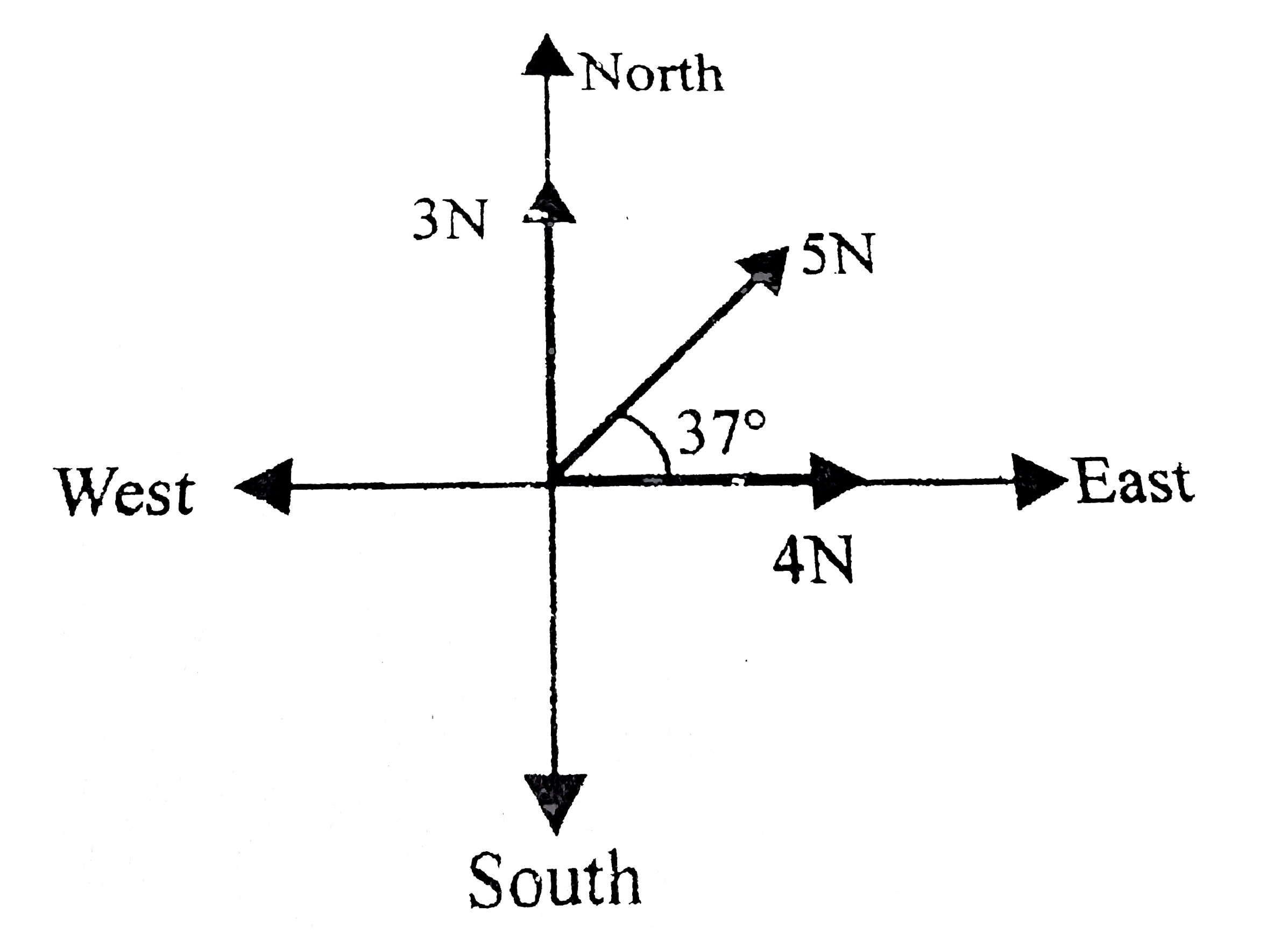A force F1, of magnitude 2.0N and directed due east is exerted on an object. A second force exerted on the object is F2=2.0N, due north. Wha tis the magnitude and direction of a third force, F3, which must be exerted on the object so that the resultant force is zero ?
1.4N,45∘ north of east
1.4N,45∘ south of west
2.8N,45∘ north of east
2.8N,45∘ south of west
The correct Answer is:D
To solve the problem, we need to find the third force F3 that will make the resultant force on the object zero when two forces F1 and F2 are already acting on it.
1. Identify the Forces:
- The first force F1 has a magnitude of 2.0N and is directed due east.
- The second force F2 has a magnitude of 2.0N and is directed due north.
2. Determine the Resultant of F1 and F2:
- Since F1 and F2 are perpendicular to each other, we can use the Pythagorean theorem to find the magnitude of the resultant force R.
R=√F21+F22=√(2.0N)2+(2.0N)2=√4+4=√8=2√2N≈2.83N
3. Determine the Direction of the Resultant Force:
- The angle θ of the resultant force with respect to the east direction can be found using:
tanθ=F2F1=2.0N2.0N=1
- Therefore, θ=45∘ north of east.
4. Find the Third Force F3:
- To make the resultant force zero, the third force F3 must be equal in magnitude and opposite in direction to the resultant R.
- Thus, F3 must have a magnitude of 2√2N and will be directed 45∘ south of west (or equivalently 225∘ from the east direction).
5. Final Result:
- The magnitude of the third force F3 is 2.83N and its direction is 45∘ south of west.
Summary:
- Magnitude of F3: 2.83N
- Direction of F3: 45∘ south of west
- The first force F1 has a magnitude of 2.0N and is directed due east.
- The second force F2 has a magnitude of 2.0N and is directed due north.
- Since F1 and F2 are perpendicular to each other, we can use the Pythagorean theorem to find the magnitude of the resultant force R.
R=√F21+F22=√(2.0N)2+(2.0N)2=√4+4=√8=2√2N≈2.83N
- The angle θ of the resultant force with respect to the east direction can be found using:
tanθ=F2F1=2.0N2.0N=1
- Therefore, θ=45∘ north of east.
- To make the resultant force zero, the third force F3 must be equal in magnitude and opposite in direction to the resultant R.
- Thus, F3 must have a magnitude of 2√2N and will be directed 45∘ south of west (or equivalently 225∘ from the east direction).
- The magnitude of the third force F3 is 2.83N and its direction is 45∘ south of west.
- Magnitude of F3: 2.83N
- Direction of F3: 45∘ south of west
Topper's Solved these Questions
- VECTORS BOOK - RESNICK AND HALLIDAYCHAPTER - VECTORS EXERCISE - PROBLEMS
34 Videos
- UNITS AND MEASUREMENT BOOK - RESNICK AND HALLIDAYCHAPTER - UNITS AND MEASUREMENT EXERCISE - PRACTICE QUESTIONS (MATRIX-MATCH)
11 Videos
- WAVE - IIBOOK - RESNICK AND HALLIDAYCHAPTER - WAVE - IIEXERCISE - PRACTICE QUESTIONS (INTEGER TYPE)
5 Videos
Similar Questions
Knowledge Check
The force exerted on an object is 200 N and its mass is 100 kg. Find the acceleration of the object.
A2ms−1B2ms−2C2ms1D20ms1Calculate the pressure exerted on an object if a force of 288 N acts on the object over an area of 0.4m2
A0.72 PaB7.2 PaC72 PaD720 PaThe forces each of 20N act on a body at 120∘ The magnitude and direction of resultant is
A20N,ϕ=60∘B20√2N,ϕ=60∘C10√2N,ϕ=0∘D10√2N,ϕ=120∘
Two forces of magnitudes 3N and 4 N act together on an object making an angle 60∘ with each other. Find the resultant force acting on the object.
View SolutionA and B are two persons playing tug of war and forces exerted by them are 50 and 30 N respectively.If C is the centre point , predict its position and find out the magitude and direction of the resulatant force?
View SolutionTwo forces of mangitude F1 and F2 are acting on an object.The magnitude of the net force Fnet on the object will be in the range.
View SolutionAn object is subjected to a force in the north-east direction. To balance this force, a second force should be applied in the direction
View SolutionLet F,FNandf denote the magnitudes of the contact force, normal force and the friction exerted by one surface on the other kept in contact. If none of these is zero,
View Solution


